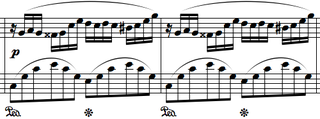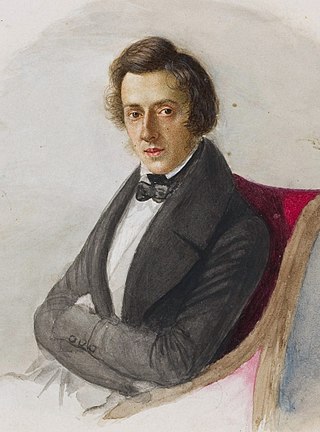Related Research Articles
Ludwig van Beethoven's Piano Sonata No. 8 in C minor, Op. 13, commonly known as Sonata Pathétique, was written in 1798 when the composer was 27 years old, and was published in 1799. It has remained one of his most celebrated compositions. Beethoven dedicated the work to his friend Prince Karl von Lichnowsky. Although commonly thought to be one of the few works to be named by the composer himself, it was actually named Grande sonate pathétique by the publisher, who was impressed by the sonata's tragic sonorities.
The Piano Quintet in F minor, Op. 34, by Johannes Brahms was completed during the summer of 1864 and published in 1865. It was dedicated to Her Royal Highness Princess Anna of Hesse. As with most piano quintets composed after Robert Schumann's Piano Quintet (1842), it is written for piano and string quartet.

The Piano Concerto No. 5 in E-flat major, Op. 73, known as the Emperor Concerto in English-speaking countries, is a concerto composed by Ludwig van Beethoven for piano and orchestra. Beethoven composed the concerto in 1809 under salary in Vienna, and he dedicated it to Archduke Rudolf, who was his patron, friend, and pupil. Its public premiere was on 28 November 1811 in Leipzig, with Friedrich Schneider as the soloist and Johann Philipp Christian Schulz conducting the Gewandhaus Orchestra. Beethoven, usually the soloist, could not perform due to declining hearing.

Beethoven's Piano Sonata No. 21 in C major, Op. 53, known as the Waldstein, is one of the three most notable sonatas of his middle period. Completed in summer 1804 and surpassing Beethoven's previous piano sonatas in its scope, the Waldstein is a key early work of Beethoven's "Heroic" decade (1803–1812) and set a standard for piano composition in the grand manner.
The Piano Sonata No. 9, Op. 68, commonly known as the Black Mass Sonata, is one of the late piano sonatas composed by Alexander Scriabin. The work was written around 1912–1913. Although its nickname was not invented by Scriabin, he approved of it.

Frédéric Chopin's Fantaisie-Impromptu in C♯ minor, Op. posth. 66, WN 46 is a solo piano composition. It was composed in 1834 and published posthumously in 1855 despite Chopin's instruction that none of his unpublished manuscripts be published. The Fantaisie-Impromptu is one of Chopin's most frequently performed and popular compositions.

The Piano Sonata No. 2 in B♭ minor, Op. 35, is a piano sonata in four movements by Polish composer Frédéric Chopin. Chopin completed the work while living in George Sand's manor in Nohant, some 250 km (160 mi) south of Paris, a year before it was published in 1840. The first of the composer's three mature sonatas, the work is considered to be one of the greatest piano sonatas of the literature.

Ludwig van Beethoven's Piano Sonata No. 16 in G major, Op. 31, No. 1, was composed between 1801 and 1802. Although it was numbered as the first piece in the trio of piano sonatas which were published as Opus 31 in 1803, Beethoven actually finished it after the Op. 31 No. 2, the Tempest Sonata.

The Piano Sonata No. 18 in E♭ major, Op. 31, No. 3, is an 1802 sonata for solo piano by Ludwig van Beethoven. A third party gave the piece the nickname "The Hunt" due to one of its themes' resemblance to a horn call. Beethoven maintains a playful jocularity throughout much of the piece, but as in many of his early works, the jocular style can be heard as a facade, concealing profound ideas and depths of emotion.
The Piano Sonata No. 3 in F-sharp minor, Op. 23, by Alexander Scriabin was composed between 1897 and 1898. The sonata consists of four movements, typically spanning 18 minutes in performance.
Beethoven's Piano Sonata No. 11 in B♭ major, Op. 22, was composed in 1800, and published two years later. Beethoven regarded it as the best of his early sonatas, though some of its companions in the cycle have been at least as popular with the public.
The Fantasie in C major, Op. 15, popularly known as the Wanderer Fantasy, is a four-movement fantasy for solo piano composed by Franz Schubert in 1822. It is widely considered Schubert's most technically demanding composition for the piano. Schubert himself said "the devil may play it," in reference to his own inability to do so properly.
Cello Sonatas No. 1 and No. 2, Op. 5, are two sonatas for cello and piano written by Ludwig van Beethoven in 1796, while he was in Berlin. While there, Beethoven met the King of Prussia Friedrich Wilhelm II, an ardent music-lover and keen cellist. Although the sonatas are dedicated to Friedrich Wilhelm II, Ferdinand Ries tells us that Beethoven "played several times at the court, where he also played the two cello sonatas, opus 5, composed for Duport and himself". Although Jean-Pierre Duport was one of the King's teachers, it is now thought to have been his brother Jean-Louis Duport who had the honor of premiering these sonatas.
Hyacinthe Jadin was a French composer who came from a musical family. His uncle Georges Jadin was a composer in Versailles and Paris, along with his father Jean Jadin, who had played bassoon for the French Royal Orchestra. He was one of five musical brothers, the best known of whom was Louis-Emmanuel Jadin.

Johannes Brahms's Violin Sonata No. 3 in D minor, Op. 108 is the last of his violin sonatas, composed between 1886 and 1888. Unlike the two previous violin sonatas, it is in four movements. The sonata is dedicated to Brahms' friend and colleague Hans von Bülow, and was premiered in Budapest in 1888 with Jenő Hubay on violin and the composer at the piano.

The Piano Concerto in F sharp minor, Op. 20, is an early work of the Russian composer Alexander Scriabin (1872–1915). Written in 1896, when he was 24, it was his first work for orchestra and the only concerto he composed. Scriabin completed the concerto in only a few days in the fall of 1896, but did not finish the orchestration until the following May. Belyayev paid the composer 600 rubles ; it premiered in October 1897 and was finally published in 1898.
Alexander Scriabin's 24 Preludes, Op. 11 is a set of preludes composed in the course of eight years between 1888–96, being also one of Scriabin's first published works with M.P. Belaieff in 1897, in Leipzig, Germany, together with his 12 Études, Op. 8 (1894–95).
Sonatas, duos and fantasies by Franz Schubert include all works for solo piano by Franz Schubert, except separate dances. They also include a number of works for two players: piano four hands, or piano and a string instrument.
References
- "Alexander Scriabin: The Piano Sonatas". Scriabin: The Piano Sonatas (CD liner). Vladimir Ashkenazy. Decca. 1997. pp. 5–7.
{{cite AV media notes}}: CS1 maint: others in cite AV media (notes) (link)